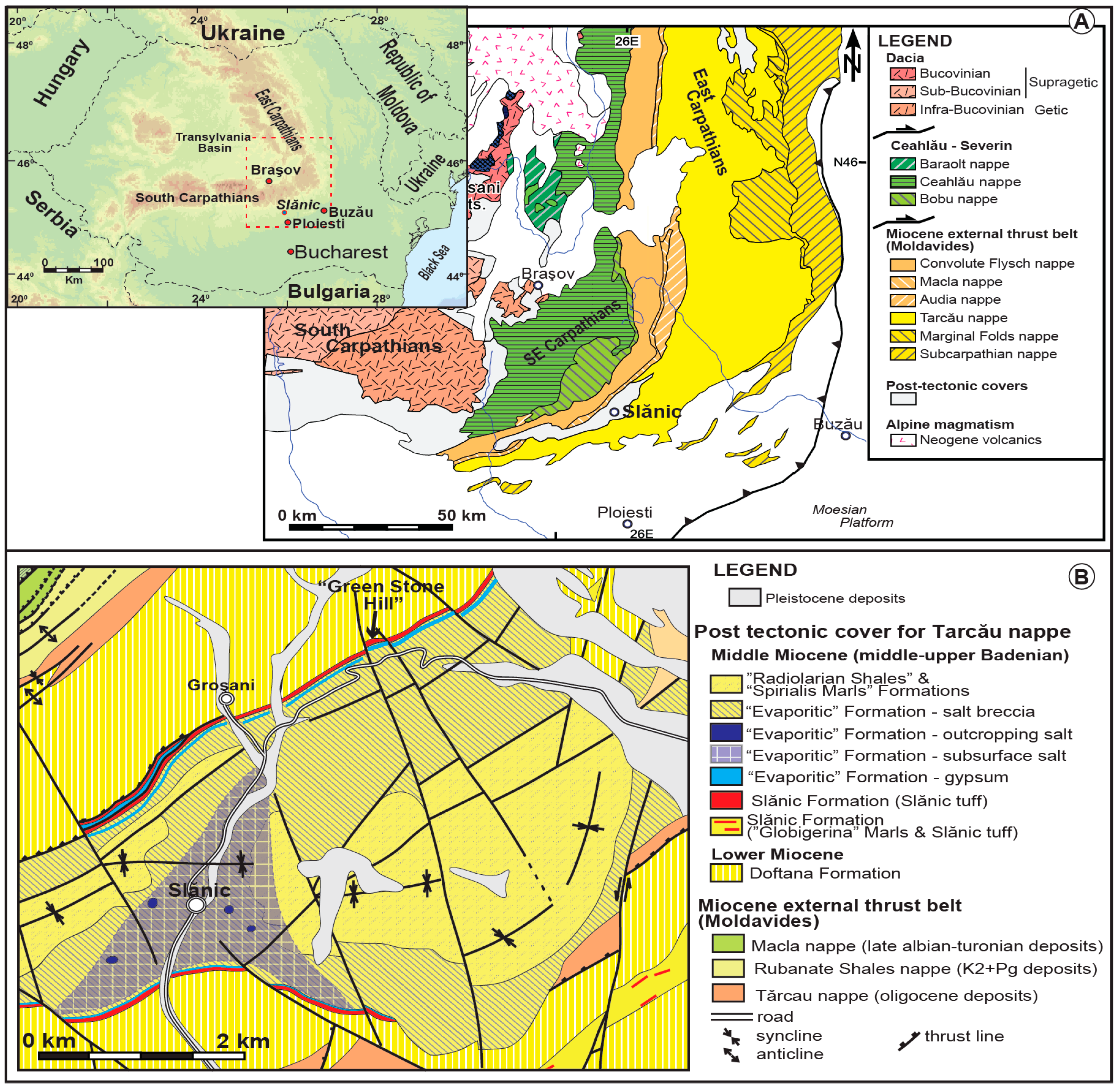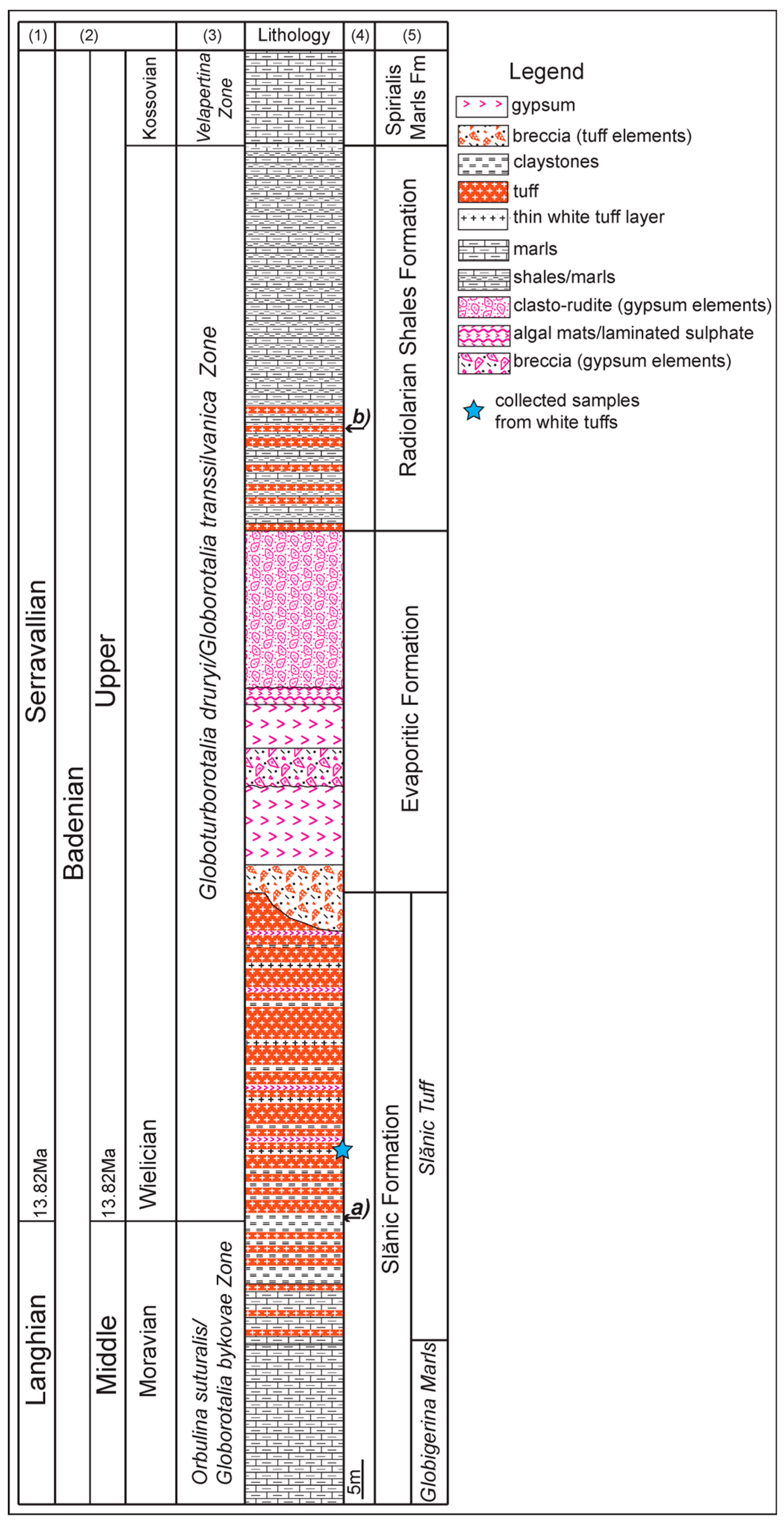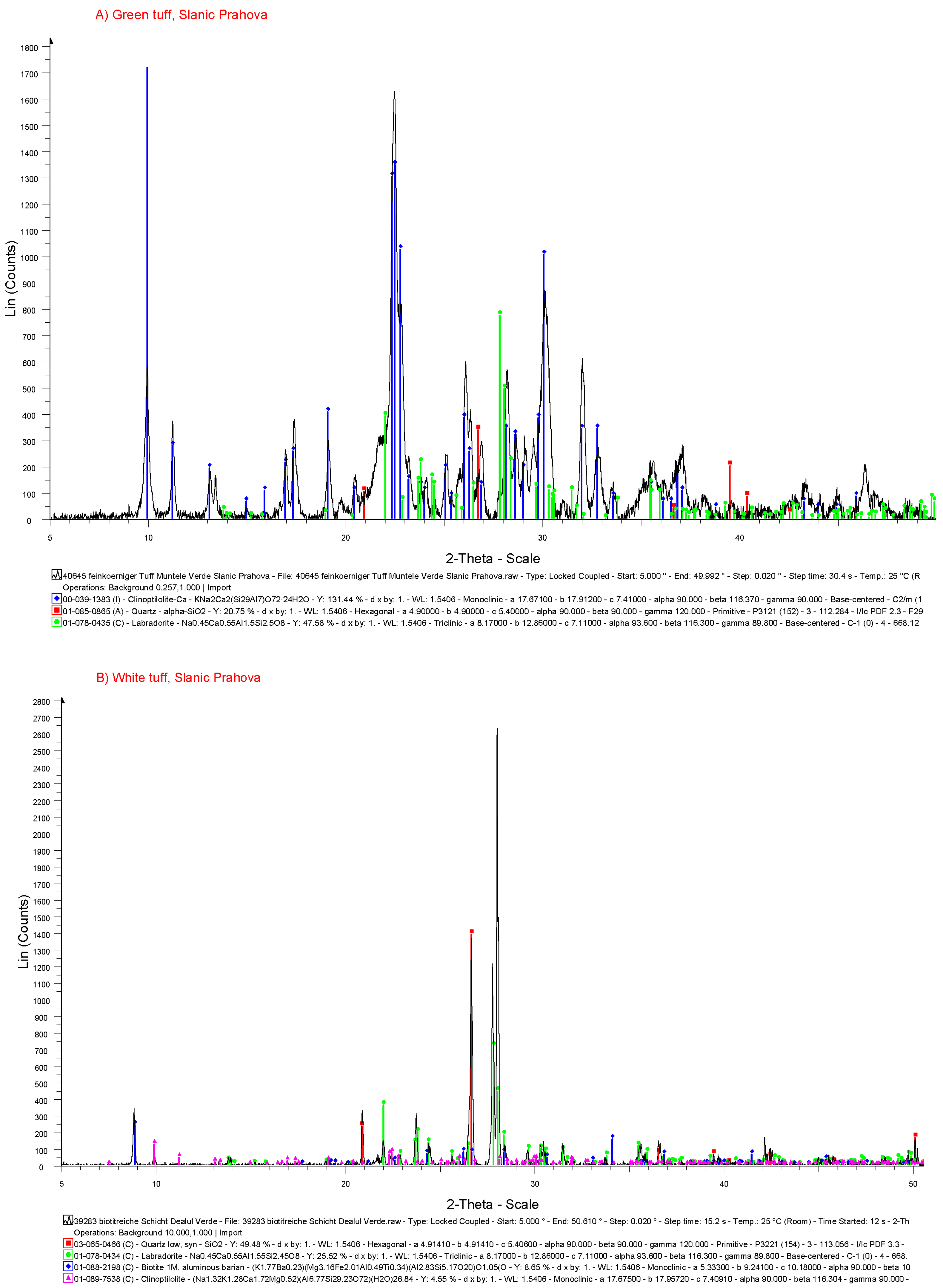Miocene Slănic Tuff, Eastern Carpathians, Romania, in the Context of Badenian Salinity Crisis
Abstract
:1. Introduction
2. Geological Setting
3. Material and Methods
3.1. XRD Investigations
3.2. Major Elements
3.3. 40Ar/39Ar Dating
4. Discussions and Conclusions
4.1. Mineralogical Composition
4.2. Major Element Composition
4.3. 40Ar/39Ar Dating
Acknowledgments
Author Contributions
Conflicts of Interest
References
- Ciupagea, D.; Păucă, M.; Ichim, T. Geology of the Transylvanian Depression; Editura Academiei R.S.R.: Bucharest, Romania, 1970; 256p. (In Romanian) [Google Scholar]
- Seghedi, I.; Szakács, A.; Vanghelie, I.; Costea, C. Zeolite formation in the lower Miocene tuffs, North Western Transylvania, Romania. Romanian J. Miner. 2000, 80, 11–20. [Google Scholar]
- De Leeuw, A.; Filipescu, S.; Maţenco, L.; Krijgsman, W.; Kuiper, K.F.; Stoica, M. Paleomagnetic and chronostratigraphic constraints on the Middle to Late Miocene evolution of the Transylvanian Basin (Romania): Implications for Central Paratethys stratigraphy and emplacement of the Tisza–Dacia plate. Glob. Planet. Chang. 2013, 103, 82–98. [Google Scholar] [CrossRef]
- Balint, R.; Calotescu, L.G.; Boero, V.; Ajmone-Marsan, F. Clay minerals clinoptilolite assemblages in two Romanian tuffs. Carpathian J. Earth Environ. Sci. 2015, 10, 27–39. [Google Scholar]
- Cochemé, J.J.; Leggo, P.J.; Damian, G.; Fülop, A.; Ledesert, B.; Grauby, O. The mineralogy and distribution of zeolitic tuffs in the Maramures Basin, Romania. Clays Clay Miner. 2003, 51, 599–608. [Google Scholar] [CrossRef]
- Damian, G.; Damian, F.; Macovei, G.; Constantina, C.; Iepure, G. Zeolitic Tuffs from Coştiui zone—Maramureş Basin. Carpathian J. Earth Environ. Sci. 2007, 2, 59–74. [Google Scholar]
- Kovács, M.; Fülop, A. Neogene volcanism in Gutâi Mts. (Eastern Carpathians): A review. Stud. UBB Geol. 2003, 48, 3–16. [Google Scholar] [CrossRef]
- Seghedi, I.; Downes, H.; Szakács, A.; Mason, P.R.D.; Thirlwall, M.F.; Roşu, E.; Pécskay, Z.; Marton, E.; Panaiotu, C. Neogene-Quaternary magmatism and geodynamics in the Carpathian–Pannonian region: A synthesis. Lithos 2004, 72, 117–146. [Google Scholar] [CrossRef]
- Bojar, A.-V.; Barbu, V.; Bojar, H.-P. Middle Miocene zeolite-bearing turbidites, Abrămuţ Basin (Pannonian Basin), NW Romania. Geol. Q. 2012, 56, 261–268. [Google Scholar] [CrossRef]
- Pécskay, Z.; Lexa, J.; Szakács, A.; Seghedi, I.; Balogh, K.; Koneèny, V.; Zelenka, T.; Kovács, M.; Póks, T.; Fülöp, A.; et al. Geochronology of Neogene magmatism in the Carpathian arc and intra-Carpathian area. Geol. Carpathian 2006, 57, 511–530. [Google Scholar]
- Bojar, A.-V.; Hiden, H.; Fenninger, A.; Neubauer, F. Middle Miocene seasonal temperature changes in the Styrian Basin, Austria, as recorded by the isotopic composition of Pectinid and Brachiopod shells. Palaeogeogr. Palaeoclimatol. Palaeoecol. 2004, 203, 95–105. [Google Scholar] [CrossRef]
- Handler, R.; Ebner, F.; Neubauer, F.; Bojar, A.-V.; Hermann, S. 4¡ã/39Ar dating of Miocene tuffs from the Styrian part of the Pannonian basin: An attempt to refine basin stratigraphy. Geol. Carpathian 2006, 57, 483–494. [Google Scholar]
- Mărunţeanu, M. Litho- and biostratigraphy (calcareous nannoplankton) of the Miocene deposits from the Outer Moldavides. Geol. Carpathian 1999, 50, 313–324. [Google Scholar]
- Calotescu, L.G.; Boero, V.; Franchini, M.A. Zeolites occurrence in Miocene pyroclastites of Slănic-Prahova (Romania). Stud. Surf. Sci. Catal. 2005, 155, 117–128. [Google Scholar] [CrossRef]
- Săndulescu, M. Geotectonica României; Editura Tehnică: Bucharest, Romania, 1984; 450p. (In Romanian) [Google Scholar]
- Ştefănescu, M.; Mărunţeanu, M. Age of the Doftana Molasse. Dări de Seamă ale Sedinţelor Institutului de Geologie şi Geofizică 1980, 65, 169–182. [Google Scholar]
- Popescu, G. Marine Middle Miocene microbiostratigraphical correlation in Central Paratethys. Dări de Seamă ale Sedinţelor Institutului de Geologie şi Geofizică 1987, 72–73, 149–168. [Google Scholar]
- Papaianopol, I.; Mărunţeanu, M. Biostratigraphie (Mollusques, Nannoplancton) du Sarmatien et du Meotien de l’est de Muntenia (Bassin Dacique, Roumanie). Analele Universităţii Al. I. Cuza 1992, 28–29, 291–300. [Google Scholar]
- Marinescu, F.; Mărunţeanu, M.; Papaianopol, I.; Popescu, G. Tables with the correlation of the Neogene deposits in Romania. Romanian J. Stratigr. 1998, 78, 181–186. [Google Scholar]
- Visarion, M.; Săndulescu, M.; Stănică, D.; Atanasiu, L. An improved geotectonic model of the East Carpathians. Rev. Roum. Géol. Géophys. Géogr. Serie Geophys. 1988, 32, 43–52. [Google Scholar]
- Maţenco, L.; Bertotti, G.; Cloetingh, S.; Dinu, C. Subsidence analysis and tectonic evolution of the external Carpathian-Moesian Platform region during Neogene times. Sediment. Geol. 2003, 156, 71–94. [Google Scholar] [CrossRef]
- Ştefănescu, M.; Rădan, S.; Micu, M.; Mărunţeanu, M.; Ştefănescu, M. Geological Map of Romania, Scale 1:50.000, Sheet 129b Slănic (Prahova); Geological Institute of Romania: Bucharest, Romania, 1978. [Google Scholar]
- Popescu, G. Observaţii asupra breciei sării şi a unor masive de sare din regiunea paleogen-miocenă a judeţului Prahova. Dări de Seamă ale Institutului Geologic 1951, 32, 3–13. [Google Scholar]
- Georgescu, O.; Frunzescu, D.; Drăgănescu, L.; Stamate, I. Considérations génétiques concernant les séquences évaporitiques de Slănic Prahova. In The Miocene from the Transylvanian Basin–Romania; Bedelean, I., Ed.; Editura Carpatica: Cluj-Napoca, Romania, 1994; pp. 217–224. [Google Scholar]
- Melinte-Dobrinescu, M.C.; Stoica, M. Badenian calcareous nannofossil fluctuation in the Eastern Carpathians: Palaeoenvironmental significance. Acta Palaeontol. Romaniae 2014, 9, 47–57. [Google Scholar]
- Dumitrică, P.; Gheta, N.; Popescu, G. Date noi cu privire la biostratigrafia si corelarea Miocenului mediu din aria carpatica. Dări de Seamă ale Sedinţelor Institutului de Geologie şi Geofizică 1975, 61, 65–81. [Google Scholar]
- Crihan, I.M. Middle Miocene Litho- and Biostratigraphical Study between Prahova Valley and Teleajen Valley, at Southern Part of the Slănic Syncline. Ph.D. Thesis, Babeş-Bolyai University, Cluj-Napoca, Romania, 1999; 138p. (In Romanian). [Google Scholar]
- Popescu, G. Lower and Middle Miocene Agglutinated Foraminifera from the Carpathian Area. Acta Palaeontol. Romaniae 1999, 2, 407–425. [Google Scholar]
- Frunzescu, D. Miocene evaporites from the southern part of Eastern Carpathians—Sedimentological approach. Romanian J. Miner. Depos. 2010, 85, 23–30. [Google Scholar]
- Hilgen, F.; Lourens, L.J.; van Dam, J.A. The Neogene period. In The Time Geologic Scale 2012; Gradstein, F.M., Ogg, J.G., Schmitz, M.A., Ogg, G.M., Eds.; Elsevier: Amsterdam, The Netherlands, 2012; pp. 1083–1127. ISBN 978-0-444-59425-9. [Google Scholar]
- Hohenegger, J.; Ćorić, S.; Wagreichv, M. Timing of the Middle Miocene Badenian Stage of the Central Paratethys. Geol. Carpathian 2014, 65, 55–66. [Google Scholar] [CrossRef]
- Popescu, G.; Crihan, I.M. Middle Miocene Globigerinas of Romania. Acta Palaeontol. Romaniae 2011, 7, 291–314. [Google Scholar]
- De Leeuw, A.; Bukowski, K.; Krijgsman, W.; Kuiper, K.F.; Stoica, M.; Tulbure, M. Chronology of the Badenian Salinity Crisis of the Central Paratethys. In Proceedings of the Paratethys-Mediterranean Interactions: Environmental Crises during the Neogene, Abstract volume RCMNS Colloqium, Bucharest, Romania, 27–28 September 2012. [Google Scholar]
- Martini, E. Standard Tertiary and Quaternary calcareous nannoplankton zonation. In Proceedings of 2nd Planktonic Conference 1970; Tecnoscienza: Roma, Italy, 1971; pp. 739–785. [Google Scholar]
- Pouchou, J.L.; Pichoir, F. Quantitative analysis of homogeneous or stratified microvolumes applying the model ‘PAP’. In Electron Probe Quantitation; Heinrich, K.F.J., Newbury, D.E., Eds.; Plenum Press: New York, NY, USA, 2012; pp. 31–75. [Google Scholar]
- Samson, S.D.; Alexander, E.C., Jr. Calibration of the interlaboratory 4¡ãAr-39Ar dating standard, MMhb-1. Chem. Geol. Isotope Geosci. Sect. 1987, 66, 27–34. [Google Scholar] [CrossRef]
- Coombs, D.S.; Alberti, A.; Armbruster, T.; Artioli, G.; Colella, C.; Galli, E.; Grice, J.D.; Liebau, F.; Mandarino, J.A.; Minato, H.; et al. Recommended nomenclature for zeolite minerals: Report of the Subcommittee on Zeolites of the International Mineralogical Association, Commission on New Minerals and Mineral Names. Can. Mineral. 1997, 35, 1571–1606. [Google Scholar] [CrossRef]
- Ijima, A.; Ogihara, S. Zeolites in Petroleum and Natural Gas Reservoirs in Japan: A Review. In Natural Zeolites ’93; Occurrence, Properties, Use; Ming, D.W., Mumpton, F.A., Eds.; International Committee on Natural Zeolites: Brockport, NY, USA, 1995; pp. 99–114. [Google Scholar]
- Sanders, C. Tectonics and Erosion, Competitive Forces in a Compressive Orogen. A Fission Track Study of the Romanian Carpathians. Ph.D. Thesis, Vrije Universiteit, Amsterdam, The Netherlands, 1998; 204p. [Google Scholar]
- Ijima, A. Zeolites in petroleum and natural gas reservoires. Rev. Miner. Geochem. 2001, 45, 347–402. [Google Scholar] [CrossRef]
- Bedelean, H.; Codrea, V.; Barbu, O. Geological and mineralogical characterization of some zeolitized tuffs from NW Transylvania, Romania. Bull. Geol. Soc. Greece 2007, 40, 666–675. [Google Scholar]
- Bedelean, H.; Măicănean, A.; Burcă, S.; Stanca, M. Investigations on some zeolitic volcanic tuffs from Cluj County (Romania), used for zinc ions removal from aqueous solution. Stud. UBB Geol. 2010, 55, 9–15. [Google Scholar] [CrossRef]
- Damian, G.; Pop, N.; Kovacs, P.P. La pétrologie des tufs volcaniques badénienne du Bassin Maramureş. In The Volcanic Tuffs from the Transylvanian Basin; Mârza, I., Ed.; Geological Formations of Transylvania, Romania; University of Cluj-Napoca: Cluj-Napoca, Romania, 1991; Volume 3, pp. 233–243. [Google Scholar]
- Peryt, T.M. The beginning, development and termination of the Middle Miocene Badenian salinity crisis in Central Paratethys. Sediment. Geol. 2006, 188–189, 379–396. [Google Scholar] [CrossRef]
- Bukowski, K.; de Leeuw, A.; Gonera, M. Isotopic Events Preceding the Badenian Salinity Crisis in the Central Paratethys, Middle Miocene, Poland. In STRATI 2013; Rocha, R., Pais, J., Kullberg, J., Finney, S., Eds.; Springer Geology: Cham, Switzerland, 2014; pp. 837–838. [Google Scholar] [CrossRef]
- Leeuw, A.; Bukowski, K.; Krijgsman, W.; Kuiper, K.F. Age of the Badenian Salinity Crisis; impact of Miocene climate variability on the circum-Mediterranean region. Geology 2010, 38, 715–718. [Google Scholar] [CrossRef]
- Wade, S.B.; Pearson, N.P.; Berggren, A.W.; Pälike, H. Review and revision of Cenozoic tropical planktonic foraminiferal biostratigraphy and calibration to the geomagnetic polarity and astronomical time scale. Earth Sci. Rev. 2011, 104, 111–142. [Google Scholar] [CrossRef]
- Anthonissen, E.; Ogg, J.G. Appendix 3. Cenozoic and Cretaceous biochronology of planktonic foraminifera and calcareous nannofossils. In The Time Geologic Scale 2012; Gradstein, F.M., Ogg, J.G., Schmitz, M.A., Ogg, G.M., Eds.; Elsevier: Amsterdam, The Netherlands, 2012; pp. 1083–1127. ISBN 978-0-444-59425-9. [Google Scholar]
- Śliwiński, M.; Bábel, M.; Nejbert, K.; Olszewska-Nejbert, D.; Gásiewicz, A.; Schreiber, B.C.; Benowitz, J.A.; Layer, P. Badenian-Sarmatian chronostratigraphy in the Polish Carpathian foredeep. Palaeogeogr. Palaeoclimatol. Palaeoecol. 2012, 326–328, 12–29. [Google Scholar] [CrossRef]
- Abdul Aziz, H.; Di Stefano, A.; Foresi, L.M.; Hilgen, F.J.; Iaccarino, S.M.; Kuiper, K.F.; Lirer, F.; Salvatorini, G.; Turco, E. Integrated stratigraphy and 4¡ãAr/39Ar chronology of early Middle Miocene sediments from DSDP Leg 42A, Site 372 (Western Mediterranean). Palaeogeogr. Palaeoclimatol. Palaeoecol. 2008, 257, 123–138. [Google Scholar] [CrossRef]
- Raffi, I.; Backman, J.; Fornaciari, E.; Pälike, H.; Rio, D.; Lourens, L.; Hilgen, F. A review of calcareous nannofossil astrobiochronology encompassing the past 25 million years. Quat. Sci. Rev. 2006, 25, 3113–3137. [Google Scholar] [CrossRef]
- Wagreich, M.; Hohenegger, J.; Ćorić, S. Base and new definition of the Lower Badenian and the age of the Badenian stratotype (Middle Miocene, Central Paratethys). In STRATI 2013; Rocha, R., Pais, J., Kullberg, J., Finney, S., Eds.; Springer Geology: Cham, Switzerland, 2014; pp. 615–618. [Google Scholar] [CrossRef]






| SiO2 | TiO2 | Al2O3 | FeO | CaO | MgO | Na2O | K2O | Loss of Ignition | Total | |
|---|---|---|---|---|---|---|---|---|---|---|
| Green tuff | ||||||||||
| 1 | 76.25 | 0.6 | 12.68 | 1.41 | 4.43 | 0.2 | 1.96 | 0.86 | 5.4 | 103.79 |
| 2 | 75.7 | 0.45 | 12.68 | 1.31 | 4.43 | 0.15 | 1.86 | 0.91 | 5.4 | 102.89 |
| 3 | 74.59 | 0.55 | 12.42 | 1.41 | 4.58 | 0.15 | 2.52 | 0.86 | 5.4 | 102.48 |
| 4 | 72.48 | 0.5 | 12.22 | 1.51 | 4.68 | 0.2 | 2.72 | 0.86 | 5.4 | 100.57 |
| 5 | 70.07 | 0.4 | 11.87 | 1.41 | 4.58 | 0.2 | 3.27 | 0.91 | 5.4 | 98.11 |
| 6 | 71.12 | 0.4 | 11.77 | 1.26 | 4.48 | 0.2 | 2.77 | 0.86 | 5.4 | 98.26 |
| 7 | 70.37 | 0.45 | 11.82 | 1.41 | 4.58 | 0.15 | 2.26 | 0.91 | 5.4 | 97.35 |
| 8 | 70.17 | 0.5 | 11.82 | 1.36 | 4.33 | 0.05 | 2.16 | 0.86 | 5.4 | 96.65 |
| Average | 72.59 | 0.48 | 12.16 | 1.39 | 4.51 | 0.16 | 2.44 | 0.88 | 5.4 | 100.01 |
| St. Dev. | 2.57 | 0.07 | 0.39 | 0.08 | 0.11 | 0.05 | 0.47 | 0.03 | 0.00 | 2.78 |
| White tuff | ||||||||||
| 1 | 76.27 | 0.13 | 10.84 | 0.94 | 4.21 | 0.67 | 0.87 | 2.21 | 11.47 | 107.61 |
| 2 | 68.04 | 0.13 | 9.7 | 0.87 | 4.01 | 0.6 | 0.87 | 2.14 | 11.47 | 97.83 |
| 3 | 69.64 | 0.2 | 10.3 | 1.07 | 4.82 | 0.8 | 0.67 | 2.21 | 11.47 | 101.18 |
| 4 | 68.91 | 0.27 | 9.83 | 0.8 | 4.01 | 0.6 | 0.87 | 2.01 | 11.47 | 98.77 |
| Average | 70.72 | 0.18 | 10.17 | 0.92 | 4.26 | 0.67 | 0.82 | 2.14 | 11.47 | 101.35 |
| St. Dev. | 3.76 | 0.07 | 0.52 | 0.12 | 0.38 | 0.09 | 0.10 | 0.09 | 0.00 | 4.41 |
| Temp. [°C] | 40Ar/39Ar | 37Ar/39Ar | 36Ar/39Ar | Time after Irradiation [day] | % of Total 39Ar | % of 40Ar * | Age [Ma] | Av. Age [Ma] |
|---|---|---|---|---|---|---|---|---|
| 1050 | 3.411 | 0.001 | 0.00195 | 166.7 | 35.1 | 83.1 | 13.9 ± 0.3 | 13.7 ± 0.2 |
| 1200 | 3.353 | 0.001 | 0.00196 | 167.5 | 41.4 | 82.8 | 13.6 ± 0.2 |
© 2018 by the authors. Licensee MDPI, Basel, Switzerland. This article is an open access article distributed under the terms and conditions of the Creative Commons Attribution (CC BY) license (http://creativecommons.org/licenses/by/4.0/).
Share and Cite
Bojar, A.-V.; Barbu, V.; Wojtowicz, A.; Bojar, H.-P.; Hałas, S.; Duliu, O.G. Miocene Slănic Tuff, Eastern Carpathians, Romania, in the Context of Badenian Salinity Crisis. Geosciences 2018, 8, 73. https://doi.org/10.3390/geosciences8020073
Bojar A-V, Barbu V, Wojtowicz A, Bojar H-P, Hałas S, Duliu OG. Miocene Slănic Tuff, Eastern Carpathians, Romania, in the Context of Badenian Salinity Crisis. Geosciences. 2018; 8(2):73. https://doi.org/10.3390/geosciences8020073
Chicago/Turabian StyleBojar, Ana-Voica, Victor Barbu, Artur Wojtowicz, Hans-Peter Bojar, Stanisław Hałas, and Octavian G. Duliu. 2018. "Miocene Slănic Tuff, Eastern Carpathians, Romania, in the Context of Badenian Salinity Crisis" Geosciences 8, no. 2: 73. https://doi.org/10.3390/geosciences8020073





